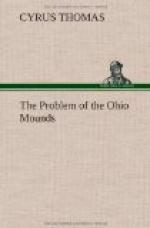As is well known, the bottle-shaped vase with a long neck is the typical form of clay vessels found in the mounds of Arkansas and southeastern Missouri, and is also common in the mounds and stone graves of middle Tennessee. Those colored or ornamented with red are often found in the mounds of the former sections. It is worthy of notice in this connection that the two localities—near Saint Genevieve, Mo., and near Shawneetown, Ill.—where so many fragments of large clay vessels used in making salt have been found, were occupied for a considerable time by the Shawnee Indians. As will hereafter be shown, there are reasons for believing this pottery was made by the Shawnees.
The statement so often made that the mound pottery, especially that of Ohio, far excels that of the Indians is not justified by the facts.
Much more evidence of like tenor might be presented here, as, for example, the numerous instances in which articles of European manufacture have been found in mounds where their presence could not be attributed to intrusive burials, but the limits of the paper will not admit of this. I turn, therefore, to the problem before us, viz, “Who were the authors of the typical works of Ohio?”
As before stated, the answer is, “These works are attributable in part at least to the ancestors of the modern Cherokees.”
As a connecting link between what has been given and the direct evidence that the Cherokees were mound-builders, and as having an important bearing upon both questions, the evidence derived from the box-shaped stone graves is introduced at this point.
CHAPTER III.
Stone graves and what they teach.
In order to state clearly the argument based upon these works it is necessary to present a brief explanation.
There are several forms and varieties of stone graves or cists found in the mound area, some being of cobble stones, others of slabs; some round, others polygonal; some dome-shaped, others square, and others box shaped, or parallelograms. Reference is made at present only to the last mentioned—the box shaped type, made of stone slabs. If the evidence shows that this variety is found only in certain districts, pertains to a certain class of works, and is usually accompanied by certain types of art, we are warranted in using it as an ethnic characteristic, or as indicating the presence of particular tribes. If it can be shown that graves of this form are found in mounds attributed to the so-called mound-builders, and that certain tribes of Indians of historic times were also accustomed to bury in them, we are warranted in assuming that there was a continuity of custom from the mound-building age to historic times, or that graves found in the mounds are probably attributable to the same people (or allied tribes) found using them at a later date. This conclusion will be strengthened by finding that certain peculiar types of art are limited to the regions where these graves exist, and are found almost exclusively in connection with them.




